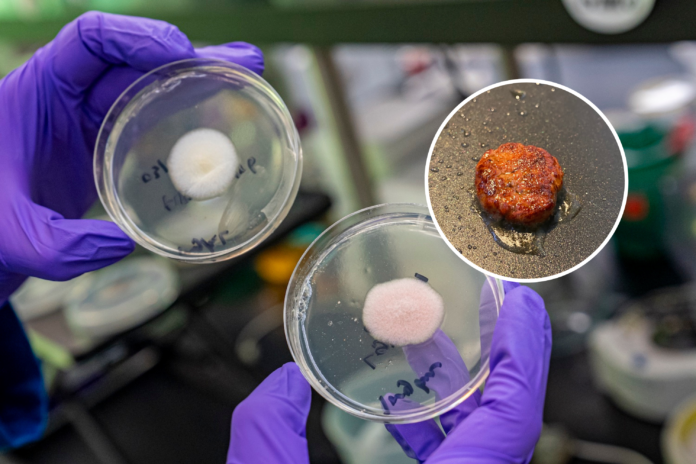Scientists have created a burger out of genetically modified “mold.”
As veganism becomes more popular, so are animal-free products—and one of the most promising sources to create this food from is fungi.
Scientists set out to learn more about a particular strain known as Koji mold, which has been used in East Asia to ferment starches. They believed that an array of possible textures and flavours could be achieved by genetically modifying the mold, and now the scientists have made a burger from it.
Their findings into the mold are published in a Nature Communications paper.
Marilyn Sargent/Berkeley Lab / Vayu Hill-Maini
“I think it’s a fundamental aspect of synthetic biology that we’re benefiting from organisms that have evolved to be really good at certain things,” Vayu Hill-Maini, a postdoctoral researcher at UC Berkeley in the lab of bioengineering expert Jay Keasling, said in a statement. “What we’re trying to do is to look at what is the fungus making and try to kind of unlock and enhance it. And I think that’s an important angle that we don’t need to introduce genes from wildly different species. We’re investigating how we can stitch things together and unlock what’s already there.”
To create the burger, scientists first developed a gene editing system that made changes to the Koji mold genome (the entire genetic material of an organism). They then continued to make changes that made the mold more appealing as a food source.
They focused on enhancing its color and also increased its production of an antioxidant associated with improvements in cardiovascular health.
These changes caused the mold to grow red. Once researchers had removed any water from the fungi, they formed it into a patty and fried it. The result was the new, genetically modified mold burger.
The next step will be to make this burger even more appealing as a food by continuing to alter its genes. By doing this, they believe they can edit the mold’s texture into something that would give it a meat-like feel.
“We think that there’s a lot of room to explore texture by varying the fiber-like morphology of the cells. So, we might be able to program the structure of the lot fibers to be longer, which would give a more meat-like experience. And then we can think about boosting lipid composition for mouth feel and further nutrition,” said Hill-Maini, who was a Fellow of the Miller Institute for Basic Research in Science at UC Berkeley during the study. “I’m really excited about how can we further look at the fungus and, you know, tinker with its structure and metabolism for food.”
Do you have a tip on a science story that Newsweek should be covering? Do you have a question about this study? Let us know via [email protected].
Uncommon Knowledge
Newsweek is committed to challenging conventional wisdom and finding connections in the search for common ground.
Newsweek is committed to challenging conventional wisdom and finding connections in the search for common ground.


